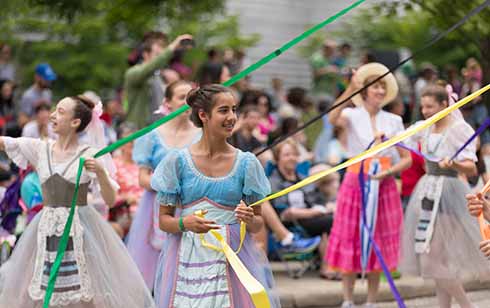 May Day means many things to different people.
May Day means many things to different people.
For some in Europe it is a time for dancing the maypole and other rituals that go back to ancient times. The first of May was the first day of summer that marked the break for farmers between the end of planting and the growth of the crop. It was a time to celebrate the fertility of the land and to pray for this year’s harvest.
CHRISTIAN MAY
When societies became Christian May was dedicated to Mary, Jesus’ mother. Sixty years ago it was still a month of devotion to Mary when the Rosary was commonly recited. Devotion to Mary as mother picked up the older theme of fertility, expressing it in spiritual terms through images of nature. Particularly in convent schools it was celebrated in procession to a statue of Our Lady during which children sang and strew flowers along the way. It culminated in the crowning of Mary as Queen.
Long before that time 1 May had also become established as the International Workers Day and a symbol of the struggle for just wages and conditions. It commemorated a strike called in Chicago to secure an eight-hour day. During it a bomb was thrown at a workers’ rally and many police were among those killed and injured. It was followed by a kangaroo court in which three workers’ advocates were condemned to death and executed.
WORKERS' STRUGGLE
Each year since, 1 May has marked the workers’ struggle, and was supported particularly strongly by Communist Trade Unions. In the Soviet Union it was an occasion to display the latest bombs and rockets. As Communist Governments spread after the Second World War and persecuted religious believers, the Catholic Church gave the day another twist, naming it the Feast of St Joseph the Worker. It never really took off – Workers’ Day had a more dramatic story and more stirring songs.
The tension between gratitude for the God’s spiritual gifts embodied in Mary and the commitment to make the world a more just place can be seen in a May Day celebration at a Convent school in the 1960s. The students were freed to make it an expression of commitment. The procession was held as usual, with the students and Sisters from the Community taking part.
Instead of flowers the girls bore groceries to be distributed to the poor; They walked exuberantly rather than prayerfully, and at the climax of the celebration let loose balloons in the school colours with such captions as ‘Make peace, not war’, while singing ‘We shall overcome’. Some older Sisters looked on unamused as the balloons lifted high towards the Harbour Bridge.
TENSION REMAINS
That is a story of a past church and a past world. But the tension symbolised in May Day remains, and indeed is sharpened by the major issue of our day: climate change. That was evident in the recent Children’s Strike for the future of the world. The tension lies between seeing the world as a gift to be celebrated joyfully and contemplatively, and as a battle field to be fought for against the forces that would exploit and destroy it: particularly the inequality that degrades both the environment and the human beings who are part of it.
This tension is part of all Christian organisations concerned for social justice, especially those which look to build communities of justice.
COME HELP ME
And then there is Mayday – the call sign of planes and ships in distress. It has nothing to do with months or seasons. It is an abbreviation of the French phrase Venez m’aider’
(Come to help me). It may suggest that we shall appreciate the world as a gift and join the struggle to save it from ruin only if we pray to God for help.
Image: Mayday dance – depositphotos.com